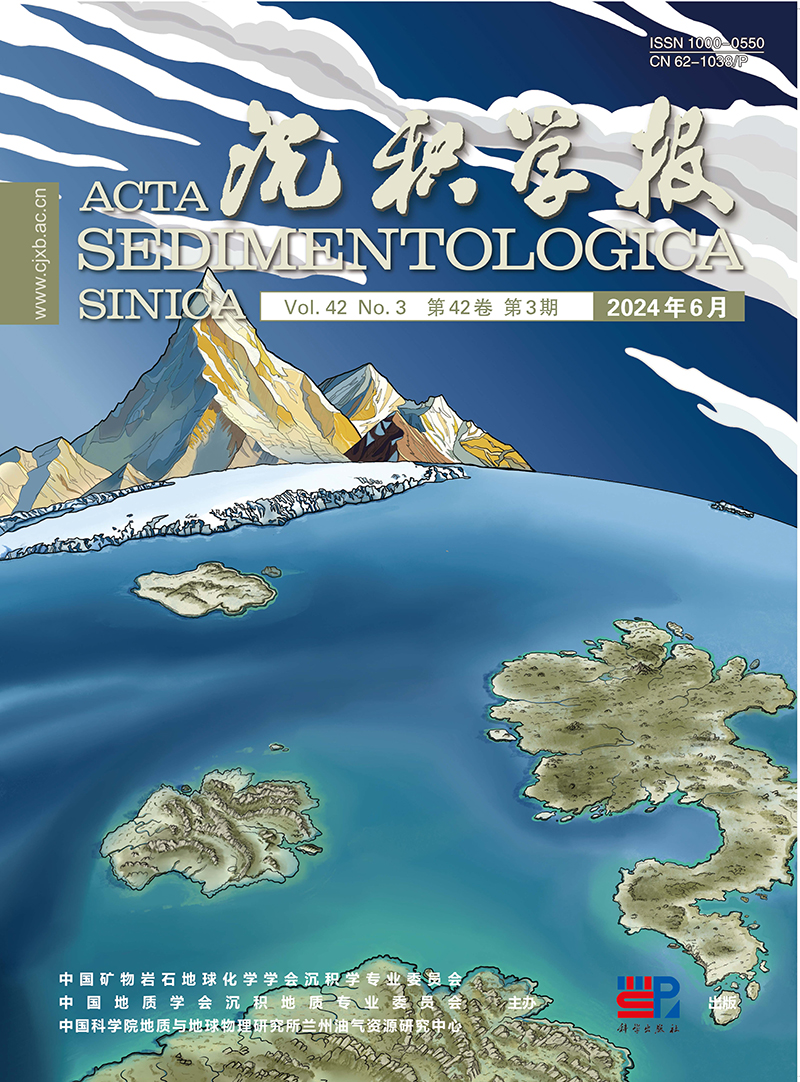HTML
-
碳酸盐台地是碳酸盐沉积物生成和堆积的主要场所,其形成与演化受控于环境(古地理格局、海平面变化等)与生物的共同作用[1⁃2]。奥陶纪生物大辐射事件(Great Ordovician Biodiversification Event,GOBE)是寒武纪以来全球海洋环境与生物协同演化的一次重大革新,当时海相碳酸盐沉积物记录了环境演化的信息[3⁃5]。因此,奥陶纪碳酸盐台地沉积相和层序的研究可以揭示碳酸盐沉积物形成和堆积过程中的沉积—构造格局及海平面变化历史[2,6],同时可为生物时空分布特征及演化规律的探讨提供重要的沉积背景和等时地层格架。
由于陆源碎屑输入的影响,扬子板块早奥陶世自南西向北东依次发育碎屑岩、碎屑岩—碳酸盐岩、碳酸盐岩等多个沉积体系[7⁃8]。前人对扬子板块早奥陶世沉积演化方面开展了大量的研究,主要集中在以下两个方面:(1)大尺度(板块范围)的古地理格局[7⁃11];(2)生物礁演化与分布[3,12⁃14]。相比之下,贵州省下奥陶统(桐梓组和红花园组)的研究主要包括:(1)单个剖面桐梓组[15⁃16]或红花园组[17]的微相及沉积环境;(2)生物地层或化石[18⁃20]。总的来说,前人研究成果在很大程度上促进了扬子板块奥陶纪沉积环境演变和区域尺度内地层对比等方面的认识。但由于碳酸盐沉积具有明显的非均一性特点[2,6,21⁃22],大尺度的沉积相分析难以满足扬子板块或贵州省早奥陶世沉积环境空间分布的精细刻画,这必然制约着扬子板块或贵州省生物空间分布特征的认识。
基于以上原因,选取贵州北部地区(黔北地区)瓢儿田剖面下奥陶统桐梓组和红花园组为研究对象,以米级尺度进行观察测量,在岩相识别及其垂向叠置特征分析的基础上,建立早奥陶世瓢儿田剖面沉积演化模式,并划分三级沉积层序。随后,通过区域沉积层序的对比分析,进一步探讨早奥陶世研究区沉积演化和层序发育的控制因素。研究成果可为早奥陶世扬子板块沉积古地理格局及其与生物系统协同演化等方面的研究提供一定的参考。
-
扬子板块的北部、西北部、西南部、东南部分别为秦岭大别山造山带、松潘甘孜(或龙门山)造山带、三江造山带、华夏地块所限(图1a)[23],其周围发育一系列的断陷盆地[24]。早古生代,扬子板块经历了加里东幕式造山运动[25],包括晚寒武世—早奥陶世的郁南运动[26⁃27]、中奥陶世末期至晚奥陶世的都匀运动(或太康运动[28])[25,27]及志留纪—泥盆纪之交的广西运动[29],它们强烈地影响着扬子板块的沉积过程及构造演化。大地构造位置上,研究区位于上扬子地区(图1a);地理位置上,研究区位于黔北地区(图1b)。本文的研究剖面(瓢儿田剖面)位于习水县东部,参考的报道剖面包括水坝塘剖面和红花园剖面,分别位于正安县西北部和桐梓县南部(图1b)。

Figure 1. (a) Geological location of northern Guizhou province (modified from reference [23]); (b) the traffic of the Piao'ertian section
黔北地区中下奥陶统自下而上依次为桐梓组、红花园组、湄潭组和十字铺组(图2)。其中桐梓组与下伏娄山关组为整合接触,含砾屑生屑灰岩为二者的界线(图3a,b),其岩性主要为灰色—深灰色中—厚层白云岩夹薄层微—细晶白云岩和生屑、砂屑或内碎屑灰岩,底部及下部夹灰绿色钙质页岩或页岩[26]。红花园组与下伏桐梓组为整合接触,以桐梓组顶部页岩夹薄层灰岩的结束和红花园组底部生屑灰岩的出现为二者的界线(图3c),其岩性主要为灰色、深灰色中—厚层生物碎屑灰岩,夹薄层生物碎屑灰岩。湄潭组与下伏红花园组为整合接触,其岩性以灰绿色、黄绿色页岩、砂质页岩为主(图3d),夹薄—厚层微晶灰岩及薄层砂岩或粉砂岩。十字铺组与下伏湄潭组为整合接触,其岩性主要为钙质页岩[26]。根据笔石和牙形类生物地层,桐梓组和红花园组的沉积时期分别为特马豆克期和弗洛期[19,26]。

Figure 2. Integrated stratigraphy of the Lower⁃Middle Ordovician successions in Guizhou province (modified from reference [26])
-
本文单层厚度描述划分标准为纹层状(<0.01 m)、薄板状(0.01~0.03 m)、薄层状(0.03~0.10 m)、中层状(0.10~0.30 m)、厚层状(0.30~1 m)、块状(>1 m)[30]。岩相特征描述中的灰岩分类采用Dunham[31]和Embry et al.[32]的分类方案,即颗粒灰岩(grainstone)、泥粒灰岩(packstone)、粒泥灰岩(wackestone)、灰泥岩(lime mudstone)、灰砾岩(rudstone)。早奥陶世研究区主要为碳酸盐缓坡沉积(见下文),相关的术语系统采用Burchette et al.[33]的缓坡模式,包括内缓坡、中缓坡、外缓坡,其中内缓坡与中缓坡的划分界线为晴天浪基面(fair-weather wave base),中缓坡与外缓坡的划分界线为风暴浪基面(storm wave base)。
在岩石岩性、宏观特征(颜色、单层厚度、沉积构造等)、岩石结构、岩石组分/组构等基础上,黔北地区瓢儿田剖面下奥陶统桐梓组和红花园组共识别出10种岩相。根据岩相的组合特征,识别出中缓坡和外缓坡2个主要的沉积相带。为了更好地对沉积相带进行讨论,将靠近内缓坡的中缓坡部分称之为上中缓坡或前滩[21,34](foreshoal),将靠近外缓坡的中缓坡部分称之为下中缓坡。
-
该沉积相带发育页岩(LF1)、薄板—薄层白云岩(LF2)、薄板—薄层生屑灰岩(LF3)、薄板—薄层球粒—鲕粒灰岩(LF4)和薄板—薄层内碎屑—球粒灰岩(LF5)5种岩相。
1) 页岩(LF1)
此类岩相的颜色以褐色、灰黑色为主(图4a);部分为钙质胶结;局部发育水平纹理。这类岩相主要分布于桐梓组和红花园组的顶部,常单独或呈夹层发育在高频米级沉积旋回的底部或下部(图4b)(具体论述见第4部分)。根据上述特征,将LF1的沉积环境解释为外缓坡至盆地[35⁃36]。
2) 薄板—薄层白云岩(LF2)
此类岩相的颜色主要为灰色、深灰色(图4b~d);单层以薄板至薄层状为主,局部为薄片状;发育水平层理或纹层、压扁层理;缝合线发育;显微镜下,以极细晶、曲面他形—半自形白云石为主,局部可见白云石层与石英纹层或泥质层互层(图4d)。此类岩相主要发育于桐梓组,常位于高频米级沉积旋回的下部(图4c)。上述特征(如单层厚度、米级沉积旋回中所处的部位等)指示LF2形成于水动力较弱的沉积环境[1,35,37];同时,水平层理或纹层说明LF2在形成过程中可能偶尔受到了风暴流的影响[34,38⁃39]。因此,将LF2的沉积环境解释为下中缓坡至外缓坡,位于风暴浪基面附近或之下。
3) 薄板—薄层生屑灰岩(LF3)
这类岩相的颜色主要为深灰色、灰色(图5a,b);单层以薄板—薄层状为主,局部为中层状;显微镜下,岩石结构主要为粒泥灰岩至颗粒灰岩、灰砾岩或漂浮岩,分选较差(图5c,d);颗粒以生屑为主,具有明显的沿长轴定向性(图5b,c),局部见少量内碎屑、零星球粒或砂级石英颗粒(图5d);生物化石主要为三叶虫、少量海百合和腕足、零星介形虫和Nuia藻;局部发育(微)冲刷面,其下部和上部的岩石结构分别为粒泥灰岩和颗粒灰岩(图5d);局部发生部分白云石化作用,但生屑未受白云石化作用的影响。此类岩相主要发育于桐梓组的底部和红花园组;常单独或与页岩呈互层状位于高频米级沉积旋回的下部。单层厚度、微晶基质支持结构和差的分选表明LF3沉积在水动力相对较弱的环境[37,40⁃41],但颗粒支持结构(如颗粒灰岩、灰砾岩等)和(微)冲刷面指示LF3形成于水动力相对较强的沉积环境[22],以上特征说明LF3沉积过程中水动力是动荡变化的。因此,将LF3的沉积环境解释为下中缓坡至外缓坡,位于风暴浪基面之上或附近,经常受到风暴流的作用。
4) 薄板—薄层球粒—鲕粒灰岩(LF4)
这类岩相的颜色以深灰色为主(图5e);单层以薄板、薄层状为主;显微镜下,岩石结构以泥粒灰岩或颗粒灰岩为主,中等—差分选(图5f,g);颗粒以正常鲕为主,其核心主要为三叶虫、内碎屑,可见少量复鲕、内碎屑、球粒;发育由不同粒径的球粒和鲕粒层构成的互层(图5f);个别鲕粒被缝合线切割,表现出锯齿状或不规则界线;生物化石可见少量三叶虫、零星腕足、双壳、介形虫。此类岩相主要发育于红花园组的底部,常构成高频米级沉积旋回的下部。鲕粒通常被认为形成在强水动力的温暖浅水环境(水体深度<5 m)[22,42],并在高能滩相发生沉积[22,34,43⁃44]。以鲕粒为主的颗粒组分及其颗粒支持结构似乎表明LF4形成于高能滩相,但单层厚度、中等—差的颗粒分选程度、不同颗粒组成的互层及其所处的高频米级沉积旋回部位并不支持这一解释。因此,将LF4的沉积环境解释为下中缓坡,位于风暴浪基面之上。由于瞬时高能风暴流的作用,高能环境形成的鲕粒被搬运至相对深水的下中缓坡,快速堆积便形成了LF4[6]。
5) 薄板—薄层内碎屑—球粒灰岩(LF5)
此类岩相的颜色以灰色为主;单层以薄板、薄层状为主;显微镜下,岩石结构以粒泥灰岩或泥粒灰岩为主,中等—差分选(图5h);颗粒主要为内碎屑和球粒;可见多个不同粒径的颗粒层、底冲刷面、正粒序层理(图5h);生物化石主要为少量三叶虫、海百合、零星腕足和介形虫。这类岩相主要发育于红花园组,并位于高频米级沉积旋回的下部。除颗粒类型不同外,LF5具有与LF4具有类似的特征。因此,将LF5的沉积环境也解释为下中缓坡,位于风暴浪基面之上,偶尔受到风暴流的影响[34,37,41]。
-
该沉积相带主要发育中层白云岩(LF6)、中层石英砂岩(LF7)、中—厚层内碎屑或球粒灰岩(LF8)、厚层—块状内碎屑或球粒—生屑灰岩(LF9)和厚层鲕粒白云岩(LF10)5种岩相。
1) 中层白云岩(LF6)
这类岩相的颜色以深灰色、灰色为主(图6a,b);单层以中层状为主,局部为厚层或块状;显微镜下,以极细晶至细晶、曲面他形—半自形白云石为主,局部可见颗粒幻影(图6c);局部可见互层状的白云石层与球粒或砂级石英颗粒层(图6d),或砂级石英颗粒呈分散状漂浮于白云石之中;发育正粒序层理(图6b)、水平层理,局部见底冲刷面。此类岩相主要发育于桐梓组,常位于高频米级沉积旋回的上部。单层厚度、颗粒含量的增多、沉积构造的发育及其所处的高频米级沉积旋回部位均表明LF6的沉积水深较LF1~LF5浅[34⁃35]。此外,单层内发育的多个正粒序层理(图6b)说明LF6沉积时期短时间尺度内水动力发生频繁的动荡变化[6]。基于上述特征,将LF6的沉积环境解释为上中缓坡,位于晴天浪基面之下,经常受到风暴流的影响。
2) 中层石英砂岩(LF7)
此类岩相的颜色以灰色为主(图7a);单层主要为中层状;显微镜下,石英颗粒的分选为中等—差,它们之间呈点和缝合接触(图7b,c),发育不同粒级的石英颗粒层;除石英颗粒外,可见白云石内碎屑和砾屑(图7b,c),个别内碎屑中见石英颗粒。这类岩相主要分布于桐梓组,常构成高频米级沉积旋回的顶部。在研究区以碳酸盐为主的沉积体系中,LF7的发育表明桐梓组沉积时期贵州省(或上扬子地区)存在一个碳酸盐—碎屑岩混合沉积体系,但LF7的零星发育说明混积过程在研究区并非广泛发育。基于上述特征,将LF7的沉积环境解释为上中缓坡,位于晴天浪基面之下,受风暴流的影响。在LF6的沉积过程中,陆源碎屑或混积体系中的石英颗粒由于受到风暴流的作用,被搬运至研究区堆积形成LF7[45⁃47]。
3) 中—厚层内碎屑或球粒砂屑灰岩(LF8)
这类岩相的颜色以深灰色、灰色为主(图7d);单层以中层、厚层状为主;显微镜下,岩石结构以泥粒灰岩或颗粒灰岩为主(图7e,f),局部为粒泥灰岩,中等—差分选;颗粒以内碎屑、球粒为主,局部可见大量砾屑,其粒径可达9 cm;生物化石主要为少量三叶虫、海百合、介形虫,零星腕足和Nuia藻。这类岩相主要分布于红花园组,常位于高频米级沉积旋回的上部。单层厚度、颗粒支撑结构及其所处的高频米级沉积旋回部位表明LF8沉积时期水动力较强[48],但不同的颗粒分选程度指示沉积过程中动荡的水动力[6,41]。此外,大量砾屑的局部发育显示LF8的沉积过程偶尔受到了强水动力(如风暴流)的作用[6]。因此,将LF8的沉积环境解释为上中缓坡,位于晴天浪基面之下[40,46,49]。
4) 厚层—块状内碎屑或球粒—生屑灰岩(LF9)
此类岩相的颜色以深灰色、灰色为主(图8a);单层以厚层、块状为主,局部为中层状;显微镜下,岩石结构主要为泥粒灰岩/颗粒灰岩、灰砾岩,中等—差分选;颗粒主要为生屑,发育少量内碎屑、球粒(图8b);生物化石以三叶虫、海百合为主,见少量腕足。这类岩相主要发育于红花园组,并位于高频米级沉积旋回的上部。单层厚度、颗粒支撑结构及其所处的高频米级沉积旋回部位显示,LF9形成于水动力较强的沉积环境[6,22,50],但不同的颗粒分选程度表明其沉积过程中动荡的水动力[6,41]。因此,将LF9的沉积环境解释为上中缓坡,位于晴天浪基面之下。
5) 厚层鲕粒白云岩(LF10)
这类岩相的颜色以灰色、浅灰色为主(图8c,d);单层以厚层状为主;显微镜下,以细晶、曲面他形—半自形白云石为主,局部可见颗粒幻影,推测原岩应为鲕粒颗粒灰岩,中等—好分选(图8e)。此类岩相主要发育于桐梓组,并位于高频米级沉积旋回的上部。单层厚度、颗粒支撑结构及其所处的高频米级沉积旋回部位显示,LF9形成于水动力较强的沉积环境[6,22],但L9与LF6和LF2的组合特征指示其并非形成在高能鲕粒滩相[34,48,51]。因此,将LF10的沉积环境解释为上中缓坡,位于晴天浪基面之下。
2.1. 下中缓坡至盆地
2.2. 上中缓坡
-
基于前人对奥陶纪扬子板块岩相古地理的研究成果[3,7⁃9,11⁃12],早奥陶世黔北地区整体应属于浅水碳酸盐岩台地沉积体系[7,15]。研究区缺乏典型的碳酸盐台地边缘礁滩相和明显的浅水—深水过渡带(即斜坡坡折带)。此外,桐梓组和红花园组的沉积厚度相对稳定,侧向厚度变化较为平缓(见第5部分)。因此,将早奥陶世研究区沉积模式解释为碳酸盐缓坡系统(图9)。

Figure 9. Depositional model of the Piao'ertian section in northern Guizhou province during the Early Ordovician
根据沉积特征的差异,可将研究区下奥陶统的沉积过程划分为两个阶段。其中第一沉积阶段(桐梓组沉积时期),以非骨架碳酸盐颗粒(non-skeletal grains)为主的沉积体系(图9a)。该时期,LF2和LF6作为主要的岩相类型,发育于整个桐梓组;LF1发育在桐梓组的下部、中部和顶部;少量LF3和LF9发育在桐梓组的底部和顶部;零星LF7和LF10发育在桐梓组的顶部和上部(图10)。第二沉积阶段(红花园组沉积时期),以骨架碳酸盐颗粒(skeletal grains)为主的沉积体系(图9b)。该时期,主要的岩相(LF3和LF9)发育于整个红花园组;少量LF5和LF8发育于红花园组的中下部;零星LF1和LF4分别发育于红花园组的顶部和底部(图10)。
-
研究区桐梓组和红花园组主要由向上变浅的高频米级沉积旋回组成(图4c、图5e、图6a、图7a,d、图8a,c)。这些沉积旋回表现出明显的非对称性,即由下部相对深水的岩相(厚度占比小)加积至上部相对浅水的岩相(厚度占比大),指示高频(五级或四级)相对海平面快速上升和缓慢下降的过程[40,52⁃53]。此外,早奥陶世瓢儿田剖面主要位于开阔海沉积环境,因此该时期研究剖面以发育开阔海沉积旋回为特征,不发育潮缘旋回[40,49]。
根据构成米级沉积旋回的岩相类型,可将桐梓组和红花园组的米级沉积旋回分别划分为四种类型(T-1~T-4和H-1~H-4;图9)。其中T-1发育在桐梓组(图10),厚度介于1~3 m,其下部由下中缓坡至盆地相岩相(LF1和/或LF2)构成,向上演变为上中缓坡岩相(LF6和LF10)(图4c、图6a、图8c、图9a);T-2分布在桐梓组的上部(图10),厚度约1.5 m,其下部以外缓坡岩相(LF1)为特征,上部则由上中缓坡岩相(LF6)组成,向上进一步转变为LF7(图7a、图9a);T-3发育在桐梓组的底部和顶部(图10),厚度介于1~2 m,其下部和上部分别为下中缓坡至外缓坡岩相(LF1和/或LF3)和上中缓坡岩相(LF9)(图9a);T-4分布在桐梓组的中部(图10),厚度介于0.5~1.0 m,其下部为下中缓坡至盆地相岩相(LF1),向上加积至下中缓坡至外缓坡岩相(LF2)(图9a)。H-1主要发育在红花园组(图10),厚度介于1~5 m,其由下部的下中缓坡至外缓坡岩相(LF3)和上中缓坡岩相(LF9)(图8a、图9b);H-2主要分布在红花园组的底部(图10),厚度介于1.0~1.5 m,由下部的下中缓坡至外缓坡岩相(LF4或LF5)和上部的上中缓坡岩相(LF9)组成(图5e、图9b);H-3主要发育在红花园组的中下部(图10),厚度介于1.0~1.5 m,其下部为下中缓坡至外缓坡岩相(LF5),上部为上中缓坡岩相(LF8)(图7d、图9b);H-4主要分布在红花园组的顶部(图10),厚度介于0.5~1.0 m,其下部为外缓坡带至盆地相岩相(LF1),向上演变为下中缓坡岩相(LF3)(图9b)。
-
在三级沉积层序分析中,采用Embry et al.[54]的海进—海退(transgressive-regressive)模式。在该层序模式中,一个完整的三级层序由下部的海进体系域(Transgressive Systems Tract,TST)和上部的海退体系域(Regressive Systems Tract,RST)构成,二者之间为最大海泛面(Maximum Flooding Surface,MFS)。在沉积相和高频米级沉积旋回识别的基础上,依据沉积相和高频米级沉积旋回垂向上的叠置特征,将黔北地区瓢儿田剖面下奥陶统桐梓组和红花园组划分为3个半三级层序,每个层序界面均为II型(即过渡性岩性界面)(图10)。
1) 层序1(Sq1)
Sq1是桐梓组发育的第一个层序,其厚度为38.5 m(图10)。随着相对海平面的升高,Sq1的海侵体系域(TST1)开始于沉积旋回T-3,其内岩相类型主要为LF3和LF9。随后,向上演变为以沉积旋回T-1为主,其内岩相类型主要为LF2和LF6。由于相对海平面的持续上升,TST1的上部进一步转变为以LF1为主的沉积组合(即“桐梓页岩”[26])(图4a),对应着最大海泛面(MFS1)。之后,相对海平面由上升转为下降,海退体系域(RST1)开始形成。整体来看,RST1内部发育两个级别更低(四级)的沉积层序。它们均由沉积旋回T-1构成,岩相类型以LF2和LF6为主。与TST1相比,RST1的岩相类型缺乏LF1。此外,岩相厚度增大,沉积构造(如正粒序层理、水平层理等)增加(图10)。
2) 层序2(Sq2)
Sq2的厚度为48.7 m。当相对海平面由下降转为上升后,TST2的下部仍以沉积旋回T-1为主,岩相类型为L2和LF6,但岩相厚度明显减小(图10、图11a)。随后,TST进一步演变为以沉积旋回T-4为主,岩相类型主要为LF1和LF2,标志着相对海平面达到最高,对应着MFS2(图11b)。整体来看,RST2内部发育两个四级层序。其中下部四级层序主要由沉积层序T-1构成,岩相类型为LF2、LF6、LF10;上部四级层序由沉积层序T-1和T-2组成,岩相类型为LF2、LF6、LF7。同时,与RST1类似,除了岩相厚度的增加,沉积构造(如丘状交错层理、正粒序层理等)也明显增多。

Figure 11. Outcrop characteristics of the critical surfaces within depositional sequences of the Lower Ordovician successions in the Piao'ertian section
3) 层序3(Sq3)
Sq3的厚度为40.5 m。RST2之后,TST3以沉积旋回T-3为主,岩相类型主要为LF3和LF9,但厚度明显减小,标志着相对海平面由下降转为上升(图10、图11c)。随着相对海平面的持续上升,TST顶部转变为以LF1为主的沉积组合,对应着MFS3。RST3则由红花园组的中下部构成,其内发育3个四级层序。下部四级层序由沉积旋回H-1、H-2和H-3构成,岩相类型主要为LF3~LF5和LF8、LF9;其他2个四级层序内的沉积旋回主要为H-1和H-3,岩相类型为LF3、LF5、LF8和LF9。
4) 层序4(Sq4)
Sq4仅发育TST或其一部分,其厚度为9.5 m。尽管TST4沉积旋回类型与RST3顶部类似,均以H-1为主,但沉积旋回厚度明显减小(图10、图11d),再次指示相对海平面由下降转为上升。整体来说,TST4的中下部由沉积旋回H-1组成,岩相类型为LF3和LF9;上部则由沉积旋回H-4构成,岩相类型为LF1和LF3(图10)。
4.1. 高频米级沉积旋回
4.2. 三级沉积层序
-
通过将黔北地区瓢儿田剖面的沉积相和沉积层序与前人研究成果进行对比分析,明确了研究区瓢儿田剖面早奥陶世沉积演化和层序发育过程的主要控制因素。
1) 相对海平面变化
碳酸盐沉积过程主要受海平面变化和沉积物供给等多种因素的控制[2,6,22,40]。海侵体系域时期,海平面上升速率大于沉积物的堆积速率,相对海平面快速上升,瓢儿田剖面海侵时期形成的岩相表现出沉积厚度减小、颗粒含量降低,同时深水岩相类型(如LF1)丰度增加(图10,12)。当相对海平面由上升转为下降时,瓢儿田剖面海退时期形成的岩相表现出沉积厚度增大、颗粒含量增加、沉积构造,如丘状交错层理、正粒序层理等增多的特征(图10,12)。

Figure 12. Stratigraphic correlation within the sequence stratigraphic framework of the Lower Ordovician successions in northern Guizhou province
另一方面,黔北地区下奥陶统垂向上的沉积演化序列(即三级层序)在横向上表现出较好的可对比性(图12),而且瓢儿田剖面三级层序的垂向叠置样式显示早奥陶世发生了更低级次(二级)海平面的上升(即海侵)过程,这与扬子板块其他地区同时期的海平面变化曲线类似[55⁃56],也与早奥陶世全球海平面长周期变化曲线基本一致(图13)[57⁃60],而且基本可与西冈瓦纳[59]及劳伦大陆[60]进行对比。虽然缺乏绝对年龄的约束,但研究区内下奥陶统三级层序与全球短周期海平面变化曲线也可进行一定的对比(图13)。此外,虽然古生代黔北地区经历了加里东幕式造山运动的作用[25],但桐梓组和红花园组沉积时期黔北地区几乎未受到这次构造作用的影响。因此,不同级次相对海平面波动是研究区下奥陶统沉积垂向演化的主要控制因素。

Figure 13. Comparison of the Early Ordovician depositional sequences or sea⁃level fluctuation curves between the study area and similar locations worldwide
2) 古地理格局
由于郁南运动的作用,中上扬子地区晚寒武世整体为西北高东南低的格局,沉积相带呈北东向展布[61]。晚寒武世沉积古地理格局也造成中上扬子地区早奥陶世的沉积相带存在明显的分带性[7,11]。例如,早奥陶世生物礁主要发育在鄂西地区(分乡组)和川南地区、黔北地区及鄂西地区(红花园组)[12,62],但扬子板块以碳酸盐沉积体系为主的其他区域则主要以非骨架碳酸盐颗粒沉积为特征[9,15⁃18]。由此可见,早期继承的沉积古地理格局对后期沉积过程有着明显的控制作用,类似的现象在其他地区也有相关报道[35,41,63⁃66]。
曹子颜等[67]通过对川南—黔北地区寒武系娄山关组沉积特征的研究,显示瓢儿田剖面和红花园剖面该时期均位于潟湖内。赵莹莹等[15]通过将黔北地区水坝塘剖面桐梓组与贵阳乌当地区小谷龙剖面进行对比,发现两个地区桐梓组具有类似的沉积特征,认为桐梓组沉积时期具有类似的沉积环境。最近的野外踏勘发现,小谷龙剖面下伏娄山关组上部发育大量的藻纹层岩和叠层石,指示其形成在潮缘沉积环境[34,37],据此推断水坝塘剖面的沉积环境应该为类似的潮缘环境。整体来看,晚寒武世水坝塘剖面位于沉积水体最浅的潮缘环境,红花园剖面和瓢儿田剖面位于沉积水体更深的潟湖环境。由于早奥陶世全球海平面的上升,红花园剖面和瓢儿田剖面的沉积环境演变为中缓坡,红花园剖面桐梓组具有与瓢儿田剖面类似的沉积序列和沉积特征(图12)。如由下部黑色页岩和上部生屑灰岩构成的米级沉积旋回(图14a,b)、正粒序层理(图14c)、大量砾屑的发育及丘状交错层理(图14d,e)。但红花园剖面桐梓组的砾屑粒径更大、发育频率更高,同时该剖面红花园组还发育一定数量的浅海造礁生物瓶筐石(Calathium)(图14f),表明红花园剖面位于沉积水体更浅的部位。相比之下,由于水坝塘剖面整体处于潮缘环境,主要发育一定数量的以微生物为主导的相关岩石类型(如叠层石、微生物颗粒灰岩等)[16]。三个剖面沉积特征的差异表明,晚寒武世沉积古地理格局对黔北地区早奥陶世沉积相带的展布起着控制作用。
-
(1) 黔北地区瓢儿田剖面碳酸盐缓坡沉积体系内共发育10种岩相类型,主要形成于碳酸盐岩缓坡沉积体系。其中桐梓组沉积时期,黔北地区瓢儿田剖面为一个非骨架碳酸盐颗粒沉积为主的沉积体系;红花园组沉积时期,演变为以骨架碳酸盐颗粒沉积为主的沉积体系。
(2) 瓢儿田剖面下奥陶统以非对称性的开阔海沉积旋回为主。在高频米级沉积旋回垂向叠置特征分析的基础上,下奥陶统可进一步识别出3个半三级层序(Sq1~Sq4),各个三级层序的层序界面均为II型界面(即岩性转换面)。Sq1~Sq3为完整的三级层序,由TST和RST构成,但Sq4仅发育TST。
(3) 瓢儿田剖面下奥陶统沉积演化过程和层序发育主要受控于不同级次的相对海平面变化和古地理格局。其中不同级次相对海平面波动则制约着沉积相的垂向演化,古地理格局控制着沉积相带的空间分布。















 DownLoad:
DownLoad:












